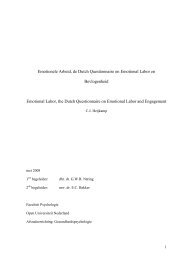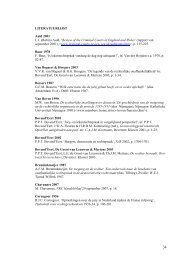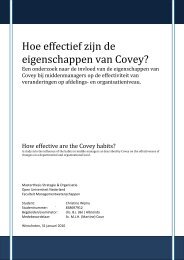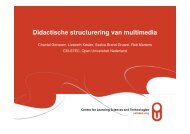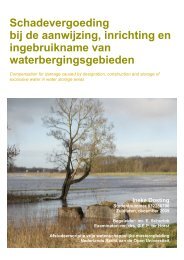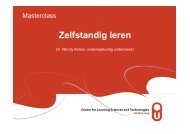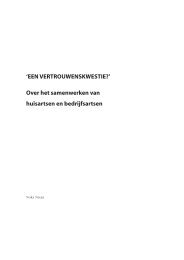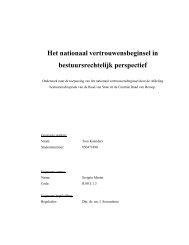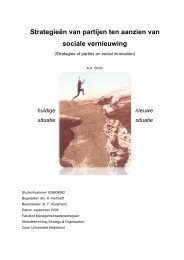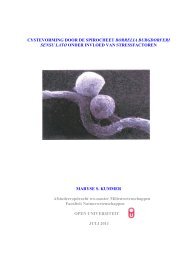Supporting Para-Teachers by Regularizing and Strengthening ...
Supporting Para-Teachers by Regularizing and Strengthening ...
Supporting Para-Teachers by Regularizing and Strengthening ...
You also want an ePaper? Increase the reach of your titles
YUMPU automatically turns print PDFs into web optimized ePapers that Google loves.
<strong>Supporting</strong> <strong>Para</strong>-<strong>Teachers</strong> <strong>by</strong> <strong>Regularizing</strong> <strong>and</strong><br />
<strong>Strengthening</strong> Planning, Enactment <strong>and</strong> Reflection of<br />
Daily Lessons<br />
HARINIRAVAL + , SUSAN MCKENNEY * AND JULES PIETERS #<br />
+<br />
Centre for Learning Resources, Pune, India<br />
*<br />
Open University of the Netherl<strong>and</strong>s, Heerlen, the Netherl<strong>and</strong>s<br />
#<br />
University of Twente, Enschede, the Netherl<strong>and</strong>s<br />
Abstract: This study describes professional development of para-teachers in an Indian<br />
educational NGO, aimed at supporting them in adopting learner centered methods. <strong>Para</strong>teacher<br />
learning was facilitated <strong>by</strong> introducing a daily routine of lesson planning, lesson<br />
enactment <strong>and</strong> lesson reflection. These were supported through workshops, microteaching,<br />
coaching activities. Interviews <strong>and</strong> lesson plan reviews reflected how para- teachers perceived<br />
their first professional development experience, what lesson planning skills they achieved<br />
<strong>and</strong> what enactment changes they perceived. The main conclusion of the study was that<br />
without any prior experience in lesson planning, through contextually suitable professional<br />
support, para-teachers tremendously gained knowledge <strong>and</strong> skills for well structured learnercentered<br />
oriented lesson planning. As compared to the pre professional development time,<br />
when enactment was ill-structured <strong>and</strong> rote-based, a shift towards better-structured <strong>and</strong><br />
learner-centered orientation was apparent.<br />
Keywords: <strong>Para</strong>-teacher, professional development, plan-enact-reflect, India.<br />
Introduction<br />
In developing countries, NGOs play important roles in delivering education,<br />
especially to disadvantaged populations. The UN millennium development goal of<br />
‘education for all’ commits governments to collaborate with NGOs in developing<br />
<strong>and</strong> disseminating educational innovations. NGOs are under pressure to step out<br />
of the charity mode, <strong>and</strong> professionalize the way they function, especially with the<br />
training of their para-educators. Studies acknowledge para-educators are valuable<br />
for their commitment, insider insights <strong>and</strong> ability to relate to the unique needs of<br />
children in difficult circumstances ((Desai, 2003; P<strong>and</strong>ey, 2006). However, concerns<br />
exist about the lack of basic education <strong>and</strong> professional teacher training of the paraeducators,<br />
which dilutes the quality of teaching learning. Increasingly, calls are being<br />
made for the professional development of para-educators in India (Jagannathan,<br />
2000) <strong>and</strong> elsewhere. Yet, the research-base for designing professional development<br />
for para-educators is limited. This research was undertaken to explore if <strong>and</strong> to what<br />
extent para-teachers in an Indian NGO learned how to prepare learner-centered<br />
lessons through focused professional development activities.<br />
Setting<br />
This study was based in an NGO called Maitri (pseudonym), in a city in western<br />
India with a population of about 4 million people. Maitri offers a variety of<br />
educational programs. The one described in this study provides educational support<br />
to slum children through learning centers within their residential communities.<br />
Staff <strong>and</strong> Educational Development International, 2012, 16 (1), 5-22, Printed in India. ISSN 0971-9008<br />
Published <strong>by</strong> Aravali Books International (P) Ltd. 2012 © Network for Staff <strong>and</strong> Educational Development
6 <strong>Supporting</strong> <strong>Para</strong>-Teacher <strong>by</strong> <strong>Regularizing</strong>.....<br />
Each center has a para-teacher recruited from the local area on a small honorarium,<br />
with qualifications ranging from 12 th grade to bachelor’s degree. <strong>Para</strong>-teachers<br />
do not have professional pre-service teacher training. 30- 40 centers are evenly<br />
distributed over 3 clusters, each run <strong>by</strong> a senior teacher called the cluster head.<br />
Since 2000, the centers have been targeting public school children up to age 14<br />
whose attainment levels in reading <strong>and</strong> basic math are very low. In 2005, the<br />
management decided that the centers would also teach advanced subject matter<br />
up to grade 7 using learner-centered methods. A central curriculum design<br />
team created materials for all centers. The management felt the need to provide<br />
professional support to assist the changes in teaching <strong>and</strong> learning. The main<br />
contextual factors that influenced the nature <strong>and</strong> design of professional support<br />
were, para-teachers’ lack of (1) prior relevant teaching experience; (2) lessonplanning<br />
skills for coherent curriculum enactment; (3) basic teaching skills to<br />
make learner-centered teaching well structured <strong>and</strong> coherent <strong>and</strong> (4) familiarity<br />
with learner-centered approaches. Key environmental factors influencing the<br />
design of the support included:<br />
●● Large <strong>and</strong> highly heterogeneous classes in terms of age <strong>and</strong> attainment<br />
levels;<br />
●● Ill-resourced environments: <strong>Para</strong>-teachers got no time to familiarize<br />
themselves with the material that they had to teach. Because of additional<br />
responsibilities, teaching took place without any prior preparation. Cluster<br />
heads’ roles predominantly involved providing administrative support.<br />
Within this context, a main objective was set to enhance the amount <strong>and</strong> quality of<br />
ongoing support, to enable para-teachers develop their repertoire of learner-centered<br />
teaching <strong>and</strong> classroom management strategies. A conceptual model was developed<br />
to shape the professional development program.<br />
Conceptual model<br />
Designing, enacting <strong>and</strong> reflecting upon the self-designed lessons are considered<br />
practical <strong>and</strong> viable routes to para-teacher learning; especially when embedded<br />
into the daily work of para-teachers. This perspective embraces an experiential<br />
<strong>and</strong> situated underst<strong>and</strong>ing of learning, in which lesson-planning <strong>and</strong> enactment<br />
serve as actual contexts of teacher work (Ball & Cohen, 1999; Davis & Krajcik,<br />
2005). Lesson-planning is viewed essentially as a process of evaluating, adapting<br />
<strong>and</strong> enacting curriculum materials in light of teachers’ own unique needs <strong>and</strong><br />
contexts (Forbes & Davis, 2008; Squire, Makinster, Barnet, Luehmann, &<br />
Barab, 2003), <strong>and</strong> based on their current competencies. Such learning <strong>by</strong> design<br />
promotes <strong>and</strong> focuses learning, providing opportunities of application as well as<br />
allowing skill <strong>and</strong> concept learning (Kolodner, 2003). Enactment is not just any<br />
activity undertaken <strong>by</strong> the teachers, but the deliberate putting into action of a<br />
new idea or practice (Clarke & Hollingsworth, 2002). In a similar vein, insight<br />
is also generated through deliberate reflection on concrete experiences (Kolb,<br />
1984). In teacher learning, reflection is referred to as the critical thoughts of<br />
teachers about their beliefs <strong>and</strong> knowledge of teaching <strong>and</strong> about the teaching<br />
practices <strong>and</strong> effects elicited <strong>by</strong> those beliefs <strong>and</strong> knowledge (Stronge, 2007;<br />
Sung, Chang, Yu, & Chang, 2009). While acts of planning, enacting <strong>and</strong>
Hariniraval,Susan Mckenney <strong>and</strong> Jules Pieters 7<br />
reflecting have the potential to serve as learning opportunities, they are rarely<br />
learning activities on their own. Rather, supportive strategies must be employed<br />
to bring out the learning from these activities. Figure 1 shows how these ideas<br />
have been brought together in a conceptual model for the on-going professional<br />
development of para-teachers.<br />
Figure1: Plan-enact-reflect activities <strong>and</strong> strategies to support them<br />
There are three supportive strategies in the model: workshops, micro-teaching<br />
<strong>and</strong> coaching aimed to facilitate the cyclic activity. This is important because<br />
para-teachers are not used to systematic planning <strong>and</strong> reflecting, <strong>and</strong> lack skills<br />
in structuring lessons <strong>and</strong> learner-centered teaching. Workshops are used to<br />
strengthen lesson-planning of para-teachers, <strong>and</strong> are a well-known professional<br />
development approach because they afford the opportunity to bring experiences<br />
from classrooms <strong>and</strong> explore new ideas (Putnam & Borko, 2000). This model<br />
adopts a combined approach which integrates learning opportunities within<br />
the daily work routines with external opportunities like workshops (Bredeson,<br />
2000). Micro-teaching experiences support enactment, serving as controlled<br />
conditions to focus on specific teaching behaviors (Allen & Eve, 1968).<br />
Coaching is viewed as a supportive strategy for reflection activities. Both<br />
micro-teaching <strong>and</strong> coaching (<strong>by</strong> peers <strong>and</strong> supervisors) during reflection are<br />
used as opportunities to learn about new strategies as well as engage in intense<br />
deliberations (Darling-Hammond & McLaughlin, 1996; Lieberman, 1996). In<br />
addition to the supportive strategies, the model suggests that organizational<br />
structures, which influence working conditions, must be examined <strong>and</strong>, if<br />
necessary, redesigned (Darling-Hammond & McLaughlin, 1996; Fullan, 1991;<br />
Fullan & Pomfret, 1977; Silins & Mulfort, 2002) to allow core activities <strong>and</strong><br />
supportive strategies to flourish. The model thus incorporates the two aspects<br />
considered critical to professional development: developing learning processes<br />
of teachers; <strong>and</strong> institutional support (Gallucci, 2008; Penuel, Fishman,<br />
Yamaguchi, & Gallagher, 2007).
8 <strong>Supporting</strong> <strong>Para</strong>-Teacher <strong>by</strong> <strong>Regularizing</strong>.....<br />
Professional development program<br />
Based on the model presented in Figure 1, a professional development program<br />
was developed. The program was introduced during the summer holidays when<br />
mainstream schools were closed. The community centers organized art classes<br />
for the children in the slum communities. <strong>Para</strong>-teachers taught only one class a<br />
day, so they could get more time to prepare for everyday lessons. This allowed<br />
them to experience lesson-planning <strong>and</strong> reflection work in a relatively low-stress<br />
environment. <strong>Para</strong>-teachers were provided with art teaching material for 30 days<br />
<strong>by</strong> the NGO, <strong>by</strong> which children could develop skills in ‘art appreciation’ <strong>and</strong> ‘art<br />
creation’. <strong>Para</strong>-teachers <strong>and</strong> their students were unfamiliar with such activity based<br />
art teaching <strong>and</strong> learning.<br />
Before the commencement of the art classes, an orientation workshop was organized.<br />
Thereafter, para-teachers reflected daily on their work <strong>and</strong> planned for the next<br />
day. Additionally, time was made for micro-teaching activities to practice the next<br />
day’s lessons. Cluster heads co-facilitated these centralized activities. A reflection<br />
activity was also scheduled every Saturday, which was facilitated <strong>by</strong> each cluster<br />
head in their respective clusters.<br />
Organizational changes conducive to these learning activities were introduced. Tasks<br />
were reorganized in order to integrate new planning <strong>and</strong> reflection routines in their<br />
timetables. Supervisors also learned to redefine their roles: redesigning their work<br />
routines, developing the lesson-planning tools, workshops <strong>and</strong> coaching. Table 1<br />
provides an overview of the professional development program elements.<br />
Table1: Professional development program elements<br />
Core Activities<br />
Daily Lesson-planning<br />
Daily Enactment of lesson plan<br />
Daily Reflection on lesson plan<br />
Weekly Reflection<br />
Supportive strategies<br />
Monthly Workshop<br />
Daily Micro-teaching<br />
Daily Coaching<br />
Material /Content<br />
A lesson plan template with elements of systematic<br />
lesson-planning described in the form of a question<br />
A simple tool with the same elements of the lesson<br />
plan,<br />
Template for each individual to support reflection<br />
on enactment experiences over the week <strong>and</strong> plan<br />
for the following week<br />
Cluster level meeting facilitated <strong>by</strong> the cluster head<br />
Material /Content<br />
Total of 6 sessions<br />
1 group discussion on use of classroom norms as<br />
behavior management strategy<br />
2 group work sessions : study, discuss <strong>and</strong> clarify<br />
how to lesson plan <strong>and</strong> reflect using templates<br />
Practicing enactment of lesson plan<br />
Peer feedback <strong>and</strong> sharing of ideas<br />
Cluster heads during enactment<br />
Peers <strong>and</strong> cluster heads during reflection <strong>and</strong><br />
lesson-planning
Hariniraval,Susan Mckenney <strong>and</strong> Jules Pieters 9<br />
<strong>Para</strong>-teachers developed daily lesson plans using a template designed to help<br />
them ‘think through’ the different aspects. This involved planning activities<br />
through simple yet detailed questions, with the additional help of teacher guides<br />
that described learner-centered activities for different concepts. The questions<br />
were flexible so that participants could borrow ideas from the teacher guides<br />
as well as brainstorm on their own. Each question was aimed at helping them<br />
operationally plan out the essential elements of curriculum (cf. Klein, 1991;<br />
van den Akker, 2003). Table 2 displays the questions in the lesson-planning<br />
template.<br />
Table 2: Lesson-planning tool inspired <strong>by</strong> curriculum components<br />
No<br />
Questions<br />
1 What is the objective of the art activity I will be doing tomorrow?<br />
2 How will I start the day in the class? Will I start with a fun activity, a game, a<br />
story or any other way? ( how much time <strong>and</strong> what material do I need for this<br />
activity)<br />
3 What type of norms are necessary to be followed <strong>by</strong> students during tomorrow‘s<br />
activity? How will I support them in deciding these? Will I scaffold <strong>by</strong><br />
demonstrating a situation, giving examples, asking questions, or any other<br />
ideas?<br />
4 What steps will I take when students will violate established conduct norms<br />
<strong>and</strong> it disrupts their work? What type of reinforcements can I use?<br />
5 How will I link the previous day’s work with the current day’s work?<br />
6 What type of instructions do I need to provide while introducing the activity so<br />
that the students clearly underst<strong>and</strong> what they are required to do during the art<br />
activity? (How much time do I need to instruct all the groups?)<br />
7 How many groups can I form for the activity <strong>and</strong> what will be those groups?<br />
8 What criteria will I use to form the groups?<br />
9 What are the detailed steps in the activity? (How much time will each group<br />
need to plan the activity <strong>and</strong> what material should I keep ready for it?)<br />
10 Based on the recommendations provided in the material what are the things I<br />
have to keep in mind as well as avoid to facilitate the group process well?<br />
11 How will I determine whether children completed the activity successfully or<br />
not?<br />
Method<br />
The main aim of the study was to underst<strong>and</strong> if <strong>and</strong> how para-teachers were able<br />
to develop lesson-planning skills through the support provided, without prior<br />
knowledge of lesson-planning. Because perceived value influences adoption of new<br />
ideas <strong>and</strong> skills, this study also examined how teachers felt about the new ways<br />
they were teaching. Three research questions guided this study:<br />
1. How did the para-teachers experience the professional development program?<br />
2. What lesson-planning skills did the para-teachers acquire?<br />
3. What are para-teacher perceptions about changes in their own classroom<br />
enactment?
10 <strong>Supporting</strong> <strong>Para</strong>-Teacher <strong>by</strong> <strong>Regularizing</strong>.....<br />
Participants<br />
Nine para-teachers, three from each of the clusters, were selected for the data<br />
collection, in consultation with the management team <strong>and</strong> the cluster heads.<br />
Procedure<br />
Lesson-planning skills were examined through document review of lesson plans<br />
<strong>and</strong> also through participant self-reporting on lesson-planning skills gained through<br />
interviews. Perceptions about classroom enactment were gained through in-depth<br />
interviews with cluster heads <strong>and</strong> participants. Table 3 reflects the data collection<br />
methods used for the different research questions.<br />
Table 3: Matching research questions with data collection methods<br />
Research question<br />
How did the para-teachers experience the professional development<br />
interventions?<br />
What lesson-planning skills did para-teachers acquire?<br />
What are the perceptions about changes in classroom enactment?<br />
Methods<br />
Participant Interviews<br />
Document Reviews<br />
Participant Interviews<br />
Cluster head interviews<br />
Participant interviews<br />
Analysis <strong>and</strong> Results<br />
Participant interview data were analyzed first. Predefined themes based on<br />
the research questions were used to categorize the data. Thereafter, analysis<br />
involved looking for new themes <strong>and</strong> recurring patterns of meaning (Merriam,<br />
1998). Document review of lesson plan was done quantitatively. From the 20<br />
lesson plans created during the four weeks, three from each week were selected<br />
at r<strong>and</strong>om for a total of 12 lesson plans per person. Altogether 108 lesson<br />
plans were analyzed. Four parameters were developed to analyze the plans:<br />
completeness, accuracy, appropriateness <strong>and</strong> detail. Answers to each question<br />
in the planning tool were coded according to these parameters. A code “y” was<br />
allotted when the question fulfilled the parameter <strong>and</strong> “n” when it did not fulfill<br />
the parameter. Scores, based on percentages of “y” codes, were used to rank<br />
participant performance on each parameter <strong>and</strong> each question. Performance<br />
scores between 0 to 33 percent were considered low, 34 to 66 percent was<br />
considered moderate <strong>and</strong> scores above 66 percent were considered high. Table<br />
4 provides the definitions of each parameter <strong>and</strong> codes given for two sample<br />
answers.
Table 4: Example of document analysis of lesson plans<br />
Hariniraval,Susan Mckenney <strong>and</strong> Jules Pieters 11<br />
Document analysis coding<br />
Excerpt from completed lesson plan<br />
<strong>Para</strong>-meters Indicators Code<br />
given<br />
Accuracy<br />
Completeness<br />
Appropriateness<br />
Detail<br />
Logical beginning <strong>and</strong> end to the<br />
answer; each question answered<br />
Question understood correctly<br />
Not stringent <strong>and</strong> easily implementable<br />
<strong>by</strong> the children; Intended<br />
for making the activity<br />
productive <strong>and</strong> not aimless, ‘for<br />
the sake of it’<br />
Answer in detail , making each<br />
step possible transparent<br />
y<br />
y<br />
y<br />
y<br />
What type of norms are necessary to<br />
be followed <strong>by</strong> students during tomorrow‘s<br />
activity? How will I support<br />
them in deciding these? Will I demonstrate<br />
some useful behavior <strong>by</strong> demonstrating<br />
a situation, giving examples,<br />
asking questions, or any other ideas?<br />
Group wise norms :<br />
Group 1 : Share materials within<br />
the group; ask for material from my<br />
group mate <strong>and</strong> not snatch it from<br />
him/her ; not getting up <strong>and</strong> leaving<br />
the group in the middle of an activity;<br />
Group 2: same as above, but also not distracting<br />
group 1 while they are working.<br />
Support in defining: To remind both<br />
groups about the norms, I will ask<br />
them to recollect these norms from<br />
yesterday’s discussion before the<br />
group activity <strong>and</strong> agree with them<br />
that we will follow these norms.<br />
I will talk to them about the advantages<br />
of following these norms from yesterday’s<br />
example. For instance, point out<br />
that there are no quarrels in the class ;<br />
the everyone gets a chance to work, we<br />
finished the activity in time, etc.<br />
<strong>Para</strong>-meters<br />
Completeness<br />
Indicators<br />
Logical beginning <strong>and</strong> end to the<br />
answer; each question answered<br />
Code<br />
given<br />
n<br />
What steps will I take when students<br />
will violate established conduct norms<br />
<strong>and</strong> it disrupts their work? What type<br />
of positive <strong>and</strong> negative reinforcements<br />
can I use?<br />
Go out of the class<br />
Accuracy Question understood correctly y<br />
Appropriateness<br />
Detail<br />
Not stringent <strong>and</strong> easily implementable<br />
<strong>by</strong> the children; Intended<br />
for making the activity<br />
productive <strong>and</strong> not aimless, ‘for<br />
the sake of it’<br />
Answer in detail , making each<br />
step possible transparent<br />
n<br />
N
12 <strong>Supporting</strong> <strong>Para</strong>-Teacher <strong>by</strong> <strong>Regularizing</strong>.....<br />
How did the para-teachers experience the professional development<br />
program?<br />
The participants shared in-depth perceptions on core <strong>and</strong> supportive strategies,<br />
particularly (a) how they viewed the specific role of the different learning activities;<br />
<strong>and</strong> (b) what specific aspects they found difficult or inconvenient about each<br />
intervention <strong>and</strong> what aspects easy <strong>and</strong> beneficial.<br />
Core activities<br />
The participants commented on the newly-added activities of lesson-planning <strong>and</strong><br />
daily reflection.<br />
Daily Lesson-planning: All participants expressed more confidence <strong>and</strong> ease in<br />
teaching because of prior preparation through lesson-planning. They reported that<br />
lesson-planning was very useful as a preparatory activity stating different reasons<br />
for it,<br />
“It became possible for me to become familiar with the materials as well as have a<br />
teaching plan based on them even though each day’s activities <strong>and</strong> materials were<br />
completely new”.<br />
And,<br />
“At the end of the planning, I could visualize two hours of teaching time <strong>and</strong> I had<br />
clarity about what to do in teaching as well as classroom management throughout<br />
the two hours of class work",<br />
Almost all the participants explained that they referred to the lesson plans when<br />
they forgot something during enactment. Most participants had found some of the<br />
questions on determining norms difficult to think about. Five participants thought<br />
that writing was more difficult initially than just thinking <strong>and</strong> talking aboutideas.<br />
Daily Reflection: A recurrent theme in the interviews was that daily reflection<br />
activities helped teachers gain a snapshot of the day <strong>and</strong> share feelings about the<br />
day’s work. Participants reported different reasons that made the daily reflection<br />
activity useful. For instance, one participant said:<br />
“New ideas got generated while reflecting <strong>and</strong> discussing everyday for addressing<br />
different aspects of the teaching process”.<br />
While another shared,<br />
“It, made things easy, as the insights I gained were already ideas for the next<br />
day”.<br />
Only one participant thought,<br />
“Sometimes those discussions go on <strong>and</strong> on; it’s a waste of time”.<br />
Six participants stated that they found it easy to review their day’s work in terms of<br />
satisfaction or dissatisfaction, but it was difficult to articulate why. Every participant<br />
felt it was easier to reflect jointly than individually. Most of the participants shared<br />
that lesson-planning <strong>and</strong> reflection felt difficult in the beginning, but with daily<br />
support <strong>by</strong> the cluster heads <strong>and</strong> peers <strong>and</strong> daily practice, it became easier.
Hariniraval,Susan Mckenney <strong>and</strong> Jules Pieters 13<br />
Weekly Reflection: Participants from two clusters shared that the cluster heads<br />
facilitated discussions based on the weekly reflection tool contents, through which<br />
the participants were able to address concerns resulting from the past week’s action<br />
or following week’s planning. One of them said that the weekly reflection was<br />
useful as,<br />
“At the end of the week I took stock of my as well as my students’ progress”.<br />
Another participant shared that,<br />
“I could get to consolidate the daily planning <strong>and</strong> reflection of the whole week”.<br />
In one cluster, participants felt that the weekly activity in their cluster was just an<br />
activity of mechanically filling the tool, where no discussion was facilitated <strong>by</strong><br />
the cluster head. Overall, participants felt they could be more independent at the<br />
later stages of planning <strong>and</strong> reflection; at the earlier stages they were much more<br />
dependent on the cluster heads <strong>and</strong> facilitator.<br />
Supportive strategies<br />
Participants also shared their experiences about the different supportive strategies<br />
employed to strengthen planning, enactment <strong>and</strong> reflection activities.<br />
Workshops: All the participants judged that that the workshop was useful as an<br />
orientation process to underst<strong>and</strong> what a practical activity looks like in reality. For<br />
instance, according to one participant,<br />
“The demonstration activities gave a mental image about the practical way of<br />
teaching art”.<br />
Or, another expressed that,<br />
“I got an idea how to use the teaching materials practically during an art<br />
activity”.<br />
A commonly expressed concern was that the practical demonstrations were easy<br />
to underst<strong>and</strong> but it was difficult to relate to the ideas that were discussed in the<br />
group-discussion about tools <strong>and</strong> disciplining strategies. Participants also shared<br />
that they had started viewing art differently in terms of what is entailed as a subject<br />
as well as how it can be taught. As one of the participants shared,<br />
“I realized that art involves creating <strong>and</strong> appreciating the things around us. This<br />
was the first time I saw what art is about <strong>and</strong> how it can be taught”.<br />
Micro-teaching: One of the predominant perceptions regarding micro-teaching<br />
experiences was that they themselves understood art differently because they<br />
had also been ‘art students’ during the micro-teaching activity. For instance one<br />
participant shared,<br />
“I learnt <strong>by</strong> creating my own drawings during micro-teaching sessions that there is<br />
so much detail one can observe when one looks at nature around. When one learns<br />
to look minutely, one can imagine <strong>and</strong> create one’s own scenery picture”<br />
Another shared that <strong>by</strong> being the learner in the micro-teaching sessions over one<br />
month, she had started believing that she could also draw <strong>and</strong> be creative, <strong>and</strong> started<br />
viewing her peers differently in terms of their art skills. She also expressed that,
14 <strong>Supporting</strong> <strong>Para</strong>-Teacher <strong>by</strong> <strong>Regularizing</strong>.....<br />
“I learnt art <strong>by</strong> doing it <strong>and</strong> slowly over time I could see that I had improved.<br />
Therefore I could also treat my students like that. I did not expect them to draw<br />
the best picture in the first instance, unlike how it was for us when we were<br />
students”.<br />
Another participant echoed a similar impression,<br />
“I <strong>and</strong> all my peers have learnt <strong>by</strong> doing. We have learnt to draw <strong>and</strong> be creative<br />
<strong>by</strong> practicing it. This is how our students will learn as well”.<br />
Participants also explained that they found micro-teaching useful to share new ideas<br />
about enactment. Across different participants they provided examples of enactment<br />
ideas gained from micro-teaching sessions, for instance, finding effective ways<br />
of explaining to students how to enact activities, modifying specific activities for<br />
fast track students, or having a sufficient repertoire of questions that can be asked<br />
so that they could provide more children with the opportunity to participate in a<br />
discussion. Some participants felt that they learned just <strong>by</strong> watching the peers enact<br />
during practice sessions. For instance one participant said.<br />
“When I saw in the practice session that my peer did not involve all the learners, I<br />
made a note that I should not do it, because the image stayed in my mind”.<br />
Many said micro-teaching was useful when they had not understood the activity<br />
well enough after reading the manual. Participants from two clusters shared that it<br />
was difficult in the first week because,<br />
“I did not feel confident of demonstrating before others”<br />
“Peers find faults for the sake of it”<br />
“Peers purposely behaved like small children <strong>and</strong> misbehaved”<br />
However they shared that this was solved soon as with practice their fear of<br />
presenting in front of others was diminished <strong>and</strong> with feedback from the cluster<br />
heads, peers slowly changed their attitude at the micro-teaching sessions.<br />
Coaching: Participants shared that their cluster heads were present everyday to<br />
support reflection on their activities; <strong>and</strong> two cluster-heads also supported the<br />
weekly reflections. Participants from all the three clusters supported each other<br />
during reflection. In all the clusters, similar coaching support was also solicited<br />
during lesson-planning, according to the participants. They consistently found<br />
planning <strong>and</strong> reflection easier over time, on account of the daily support available<br />
for the heads <strong>and</strong> the peers. A comment, supported <strong>by</strong> many others,<br />
“Often when I reflected on my class, I could not think of how I could solve a<br />
difficulty, but if the cluster head was present, she would identify a strategy that she<br />
had observed in my peer’s class which would be helpful to me, <strong>and</strong> ask her to share<br />
it with me. So I got new ideas <strong>and</strong> we also learnt to bring out more examples from<br />
our own practice to help our peers because of the coach’s facilitation”.<br />
What lesson-planning skills did the para-teachers acquire?<br />
A review of the planned lessons together with interview data helped address this<br />
question. As indicated in Table 5, the mean scores from each cluster were quite<br />
high, with over 66 percent for completeness, accuracy <strong>and</strong> appropriateness of their<br />
lesson-plans. However, the mean score for detailing of the questions was much
Hariniraval,Susan Mckenney <strong>and</strong> Jules Pieters 15<br />
lower. For detailing, two participants scored low, below 33 percent, <strong>and</strong> the rest<br />
achieved a moderate score.<br />
This indicates that these participants paid greater attention to ensuring that they<br />
understood the questions correctly <strong>and</strong> came up with legitimate classroom teaching<br />
strategies for each question.<br />
Table5: Mean percentage scores of participants on quality parameters in lessonplanning<br />
Participant<br />
(pseudonyms)<br />
Cluster Complete<br />
Accurate Appropriateness Detailing<br />
Meera A 68% 68% 69% 51%<br />
Harsha A 75% 77% 76% 60%<br />
Varuna A 67% 75% 75% 32%<br />
Sarojini B 82% 85% 85% 55%<br />
Avnita B 76% 86% 86% 50%<br />
Shubhlaxmi B 76% 79% 79% 47%<br />
Mital C 86% 95% 93% 35%<br />
Ch<strong>and</strong>a C 67% 75% 75% 32%<br />
Sanjana C 71% 95% 94% 51%<br />
Mean score<br />
per parameter<br />
74% 82% 81% 46%<br />
Table 6 gives the mean scores for each question. Questions where participants had<br />
scored high, that is, above 66 percent, in order of ranking were:<br />
Q2. Introductory activity<br />
Q5. Linking the day’s work with previous day<br />
Q10. Strategies to steer the group process based on recommendations in the<br />
material<br />
Q11. Concluding activity<br />
Q6. Providing clear directions to the students when assigning a group activity<br />
Q7. Formation of groups<br />
Q1. Objective of the activity<br />
The other questions ranked in order in the moderate category (scoring below 66<br />
percent) were:<br />
Q8.Criteria for determining sub groups<br />
Q3.Defining norms<br />
Q4.Reinforcing norms<br />
Q9.Main steps of the activity
16 <strong>Supporting</strong> <strong>Para</strong>-Teacher <strong>by</strong> <strong>Regularizing</strong>.....<br />
Table6: Mean percentage score per question <strong>and</strong> per participant<br />
Question<br />
Meera Harsha Varuna Sarojini Avnita Shubhlaxmi<br />
Mital Ch<strong>and</strong>a Sanjana mean<br />
1 75 75 60 68 75 68 68 60 75 69<br />
2 100 80 98 98 98 98 100 98 83 94<br />
3 15 35 60 70 63 70 78 60 55 56<br />
4 8 25 73 63 58 63 70 73 70 56<br />
5 100 100 70 95 98 23 88 70 95 82<br />
6 98 98 48 93 85 93 73 48 80 79<br />
7 88 90 60 48 88 48 70 60 75 69<br />
8 28 30 58 63 63 63 73 58 78 57<br />
9 40 80 45 55 30 55 76 45 63 54<br />
10 68 80 68 98 80 98 95 68 90 83<br />
11 88 100 45 98 88 98 61 45 93 79<br />
Part.<br />
Total<br />
score<br />
64 72 62 77 75 70 77 62 78<br />
When lesson plan scores per week were compared, they reflected no substantial<br />
difference between week 1 <strong>and</strong> week 4 for any participant. All participants started with<br />
a high or moderate mean percentage score, <strong>and</strong> retained that over the four weeks.<br />
Interview data showed that participants had acquired a systematic approach to<br />
planning lessons. A common response was.<br />
“I have learnt to plan my lessons in a step <strong>by</strong> step manner”.<br />
Participants discussed that they began to pay attention to aspects like beginning<br />
the lesson, <strong>and</strong> the lesson objective. Some perceptions were,<br />
“I pay attention to having a good introductory activity, because when the class<br />
begins in an enjoyable way, students become motivated <strong>and</strong> attentive”.<br />
“There was no objective for any of my class activities earlier but now I learnt to<br />
write down objective of each activity”.<br />
“I learnt that I have to determine whether the objective is achieved or not, instead<br />
of just leaving the activity open ended”.<br />
Most participants indicated that they could plan time better. One said,<br />
“Planning helped me to allocate time for each step <strong>and</strong> therefore the overall time<br />
for the class”.<br />
Another commonly acknowledged learning was about planning activity steps <strong>and</strong><br />
materials. Participants shared,<br />
“Planning the learning activity helped in thinking step <strong>by</strong> step for the activity <strong>and</strong><br />
how <strong>and</strong> when to use what material”<br />
“I learnt how to plan for using the materials in a more organized manner based on<br />
the relevant stage in the activity <strong>and</strong> not r<strong>and</strong>omly”
Hariniraval,Susan Mckenney <strong>and</strong> Jules Pieters 17<br />
“It has helped me in making the activity simpler through examples <strong>and</strong><br />
questions”<br />
Participants also talked at length about grouping children <strong>and</strong> planning appropriate<br />
learning tasks for groups. For instance,<br />
“During February <strong>and</strong> March (before the interventions), I took into consideration<br />
only 2-3children, e.g. which math sums I would give to std. 6th <strong>and</strong> 7th kids. But<br />
during art trunk, <strong>and</strong> <strong>by</strong> filling the planning, I learnt to plan for each <strong>and</strong> every child<br />
as well as the classroom on the whole, as I had divided the class in groups”<br />
Participants thought aloud about how they now paid attention to forming classroom<br />
norms. Several said lesson-planning,<br />
“Helped me in making norms <strong>and</strong> following the norms along with children”<br />
But they also shared that they found it difficult to think of specific norms<br />
everyday or to find new ways of reinforcing them. Some of the participants<br />
admitted that they often skipped that question because they did not know how<br />
to address it.<br />
What are para-teacher perceptions about changes in their own<br />
classroom enactment?<br />
Data to answer this question was gathered mainly from cluster heads who, based on<br />
observations, shared their perceptions of enactment aspects that were satisfactorily<br />
achieved <strong>and</strong> those aspects which should be reinforced in subsequent versions of<br />
this program. The biggest change all three witnessed was that the para-teachers<br />
had ceased to follow a whole class teaching approach <strong>and</strong> worked with students in<br />
groups. For instance, one of them confidently stated,<br />
“You can come <strong>and</strong> make a surprise visit to any of my class <strong>and</strong> I assure you, that you<br />
will not find the teacher teaching the whole class for the entire teaching time”.<br />
The cluster heads also shared that majority of the times during their classroom visits<br />
they had found teachers <strong>and</strong> students engaged in the activity based methods <strong>and</strong> not<br />
the traditional way of teaching art. The teachers tried to engage children <strong>by</strong> using<br />
questions <strong>and</strong> real life examples for discussion <strong>and</strong> explanation, <strong>and</strong> systematically<br />
conducted the class from introduction to conclusion. The cluster heads shared their<br />
perceptions like,<br />
“Now one does not find the teacher shouting to control the chaos in the class like<br />
earlier”.<br />
“Most of my teachers are more patient”<br />
However, all three cluster heads expressed that theactual activity gets diluted in<br />
enactment. For instance one cluster head shared that<br />
“During a micro-teaching session, they may have discussed many more examples<br />
of questions that can be asked for involving children in a discussion, however many<br />
are forgotten during the actual class”.<br />
Another center head explained the reason for this saying<br />
“<strong>Para</strong>-teachers do not integrate all suggestions of peers into their lesson plan, <strong>and</strong>
18 <strong>Supporting</strong> <strong>Para</strong>-Teacher <strong>by</strong> <strong>Regularizing</strong>.....<br />
therefore they often forget the ideas”.<br />
Another concern shared was that most para-teachers tried to formulate behavior<br />
norms with children but did not consistently reinforce desirable behavior <strong>and</strong><br />
discourage non-desirable behavior. As a result, children discussed ‘how to behave’<br />
but often slipped into old behavior.<br />
<strong>Para</strong>-teachers also reflected on their own classroom practices. They felt that they<br />
knew how to group children, use a practical activity to teach art as well as teach in<br />
a more structured way. However, their main concerns were how to use this practical<br />
approach with other subjects like math <strong>and</strong> science; <strong>and</strong> regulating the behavior of<br />
children more effectively.<br />
Conclusion<br />
This study looked for evidence to indicate if <strong>and</strong> to what extent participants have<br />
acquired lesson planning skills as a result of the professional development. As lesson<br />
planning support was provided through various strategies, the study also looked<br />
for how the para-teachers experienced them. Moreover, lesson planning is meant<br />
to enhance their own enactment, <strong>and</strong> if the participants did not experience more<br />
satisfying classroom experiences, lesson planning would not be meaningful. Hence,<br />
the study explored perceptions about changes in classroom enactment, as well.<br />
Overall, the participants’ first professional development experience was positive.<br />
Their interview responses indicate that each core <strong>and</strong> support strategy contributed to<br />
their professional learning <strong>and</strong> confidence. Their perceptions also clearly highlight<br />
some attributes of the professional development which contributed to the positive<br />
experience. These include more practical strategies like demonstrations <strong>and</strong> microteaching;<br />
joint rather than individual planning <strong>and</strong> reflection; immediate ongoing<br />
support <strong>by</strong> coaches during daily planning <strong>and</strong> reflection; <strong>and</strong> active facilitation <strong>by</strong><br />
the coach during weekly reflections.<br />
An additional conclusion is that para-teachers learned lesson-planning skills through<br />
this professional development experience. Most participants got a high or moderate<br />
score for quality parameters of completeness, accuracy <strong>and</strong> appropriateness as<br />
well as for the different questions. Such scores as well as the interview data,<br />
help to conclude that para-teachers had gained considerable knowledge about<br />
different components that lead to a well-structured lesson plan, for example, topic<br />
introduction, step <strong>by</strong> step application of learning activity <strong>and</strong> materials or lesson<br />
conclusion. Similarly, both types of data reflect a learner-centered orientation in<br />
choices about grouping, questions, examples <strong>and</strong> practical activities. Overall, as<br />
compared to the pre-professional development period, when teaching was illstructured<br />
<strong>and</strong> incoherent, as well as rote-based, the findings of this study indicate a<br />
strong shift towards better structured <strong>and</strong> learner-centered lesson-planning skills.<br />
Perceptions from both para-teachers <strong>and</strong> cluster heads indicate that para-teachers’<br />
enactment had improved in terms of being more systematic <strong>and</strong> more learnercentered<br />
as compared to what it was before the professional development experience.<br />
Cluster heads were confident that classroom teaching practices reflected greater<br />
use of group work over whole class methods, more practical learning activities,<br />
<strong>and</strong> questions <strong>and</strong> examples instead of rote methods. Cluster heads felt that there<br />
was dilution between lesson-planning <strong>and</strong> enactment. This can be explained in two<br />
ways. On one h<strong>and</strong>, it takes experience to transfer knowledge to practice (which
Hariniraval,Susan Mckenney <strong>and</strong> Jules Pieters 19<br />
these para-teachers lacked) <strong>and</strong> on the other h<strong>and</strong>, the participants’ lesson plans<br />
were not worked out in sufficient detail. Both lesson-planning <strong>and</strong> interview data<br />
helped identify that para-teachers continued to experience difficulty in planning<br />
for <strong>and</strong> implementing disciplining strategies successfully.<br />
Discussion<br />
This study clearly showed that para-teachers had learned from the professional<br />
development program. Learning about lesson planning was almost completely<br />
achieved during the first week of the program, <strong>and</strong> remained relatively stable<br />
over four weeks. This suggests that that the initial uptake of the lesson-planning<br />
skills was strong, <strong>and</strong> despite dealing with new topics to be taught every day, the<br />
initial momentum was well-retained throughout the whole month. Educational<br />
innovations very often do not succeed because teachers learn about new things but<br />
do not necessarily retain or implement them. In this study, lesson plans suggest<br />
high retention <strong>and</strong> interviews also reflect participants’ enthusiasm about using<br />
lesson plans.<br />
Three factors likely contributed to the high <strong>and</strong> stable levels of retention. First,<br />
there was ongoing support for joint lesson-planning. Second, basic <strong>and</strong> leanercentered<br />
pedagogical concepts to be learnt <strong>by</strong> the participants were very carefully<br />
chosen, while, keeping their capacities in mind. Strategies like group work, practical<br />
activities, <strong>and</strong> questions were some approaches that were chosen as realistic learnercentered<br />
aspects. Sullivan (2004) in a study conducted in Namibia, asserted the<br />
need for selecting simple achievable learner-centered skills which would begin<br />
to lead teachers away from traditional approaches. Such approaches may not be<br />
ideal learner-centered approaches, but could potentially lead to the successful<br />
development of teachers’ capacities to implement learner-centered approaches in<br />
the future (Sullivan, 2004).<br />
Third, the immediacy of daily lesson-planning with enactment helped. <strong>Para</strong>-teachers<br />
could use everyday planning in the course of their daily work, <strong>and</strong> it did not use up<br />
additional time. Embedding learning activities into the daily time table has been<br />
viewed as important for workplace learning <strong>and</strong> teacher development (Bredeson,<br />
2000; Loxley, 2007). Further, each day’s learning activity focused on content to<br />
be taught immediately; a factor which has been emphasized in the professional<br />
development of under-trained teachers (Ru<strong>by</strong>, 2006).<br />
The scores remained relative static over the four weeks, <strong>and</strong> several explanations<br />
might account for this:<br />
- Since the initial uptake was high among many para-teachers, there could have<br />
been a ceiling effect, in which para-teachers rapidly achieve high proficiency<br />
levels of basic skills but it takes much more time to reach a higher level.<br />
- Planning, reflection <strong>and</strong> writing are both new <strong>and</strong> difficult procedural skills<br />
for para-teachers.<br />
- <strong>Para</strong>-teachers were planning for new subject matter topics everyday within<br />
60- 90 minute periods during which they had to study the teacher guides <strong>and</strong><br />
adapt the characteristics to their lesson-planning templates, this time may<br />
have been to short.<br />
- With new procedural skills, new subject matter, new learner-centered
20 <strong>Supporting</strong> <strong>Para</strong>-Teacher <strong>by</strong> <strong>Regularizing</strong>.....<br />
approach <strong>and</strong> little time for planning, para-teachers may have focused more on<br />
maintaining a basic level of planning quality, <strong>and</strong> may have found it difficult<br />
to consolidate <strong>and</strong> incorporate new ideas in to their lesson plans.<br />
- Each cluster head had to support about ten para-teachers while also having<br />
no experience working with lesson plans or teaching the art content. Hence,<br />
the coaching support was very valuable in terms of providing motivation <strong>and</strong><br />
helping with basic doubts, but less effective in terms of helping the quality<br />
of lesson-planning improve substantially after the first week, during which<br />
several senior management team people were present as facilitators.<br />
- The quality parameters only help view very basic development in the lessonplanning<br />
skill, subtleties in the lesson plans may have been overlooked.<br />
This article speaks to researchers <strong>and</strong> practitioners who are studying <strong>and</strong><br />
creating professional development for para-teachers working in under-resourced<br />
environments. It demonstrates that appropriate preparation for para-teachers through<br />
adequate professional development can lead to positive learning experiences <strong>and</strong><br />
new skills. This approach may address criticism about the low level of training of<br />
these highly-motivated, much-needed teachers.<br />
References<br />
wAllen, D. W., & Eve, A. W. (1968). Microteaching. Theory into Practice, 7(5), 181-185.<br />
Ball, D., & Cohen, D. (1999). Developing practice, Developing practitioners. In G. Sykes & L.<br />
Darling-Hammond (Eds.), Teaching as the learning profession : H<strong>and</strong>book of policy <strong>and</strong> practice<br />
(pp. 3-32). San Francisco: Jossey-Bass.<br />
Bredeson, P. V. (2000). Teacher Learning as Work <strong>and</strong> at Work: exploring the content <strong>and</strong> contexts<br />
of teacher professional development. Journal of In-Service Education, 26(1), 63.<br />
Clarke, D., & Hollingsworth, H. (2002). Elaborating a model of teacher professional growth. [doi:<br />
DOI: 10.1016/S0742-051X(02)00053-7]. Teaching <strong>and</strong> Teacher Education, 18(8), 947-967.<br />
Darling-Hammond, L., & McLaughlin, M. W. (1996). Policies that Support Professional Development<br />
in an Era of Reform. In M. W. O. McLaughlin, I. (Ed.), Teacher Learning : New Policies, New<br />
Practices. New York: <strong>Teachers</strong> College Press.<br />
Davis, E. A., & Krajcik, J. S. (2005). Designing Educative Curriculum Materials to Promote Teacher<br />
Learning. Educational Researcher, 34(3), 3-14.<br />
Desai, V. (2003). Emerging Staffing Issues in Grassroots Urban NGOs: The Case of Mumbai<br />
Global Built Environment Review, 3(1).<br />
Forbes, C. T., & Davis, E. A. (2008). The development of preservice elementary teachers’ curricular<br />
role identity for science teaching. Science Teacher Education, 92, 909-940.<br />
Fullan, M. (1991). The New Meaning of Educational Change. Great Britain: Casell Educational<br />
Limited.<br />
Fullan, M., & Pomfret, A. (1977). Research on Curriculum <strong>and</strong> Instruction Implementation. Review<br />
of Educational Research.<br />
Gallucci, C. (2008). District wide instructional reform : Using sociocultural theory to lihnk professional<br />
learning <strong>and</strong> organizational support. American Journal of Education, 114.<br />
Jagannathan, S. (2000). The Role of Nongovernmental Organizations in Primary Education: A Study<br />
of Six NGOs in India.<br />
Kolb, D. (1984). Experiential Learning : Experience as the source of learning <strong>and</strong> development.<br />
New Jersey: Prentice-Hall, Inc.
Hariniraval,Susan Mckenney <strong>and</strong> Jules Pieters 21<br />
Kolodner, J. L. (2003). Problem-Based Learning Meets Case-Based Reasoning in the Middle-School<br />
Science Classroom: Putting Learning <strong>by</strong> Design Into Practice 1. The Journal of the Learning<br />
Sciences, 12(4), 495.<br />
Lieberman, A. (1996). Practices that Support Teacher Development : Transforming Conceptions of<br />
Professional Learning. In M. W. O. McLaughlin, I. (Ed.), Teacher Learning : New Policies, New<br />
Practices. New York: <strong>Teachers</strong> College Press.<br />
Loxley, A. (2007). The role of whole-school contexts in shaping the experiences <strong>and</strong> outcomes<br />
associated with professional development. Journal of In-Service Education, 33(3), 265.<br />
Merriam, S. B. (1998). Qualitative Research <strong>and</strong> Case Study Applications in Education. San Fransisco:<br />
Jossey-Bass.<br />
Osullivan, M. (2004). The reconceptualisation of learner-centred approaches: a Namibian case study.<br />
International Journal of Educational Development, 24(6), 585.<br />
P<strong>and</strong>ey, S. (2006). <strong>Para</strong> Teacher Scheme <strong>and</strong> Quality Education for All in India : The Policy<br />
Perspectives <strong>and</strong> Challenges for School Effectiveness. New Delhi: National Council for Educational<br />
Research <strong>and</strong> Training.<br />
Penuel, W. R., Fishman, B., J., Yamaguchi, R., & Gallagher, L. (2007). What makes professional<br />
development effective? Strategies that foster curriculum implementation. Americal Educational<br />
Research Journal, 44(4).<br />
Putnam, R., & Borko, H. (2000). What do new ways of research <strong>and</strong> thinking have to say about<br />
research on teacher learning? Educational Researcher, 29(1), 4-15.<br />
Ru<strong>by</strong>, A. (2006). Improving Science Achievement at High-Poverty Urban Middle Schools. Wiley<br />
Periodicals, Inc., 90, 1005-1027.<br />
Silins, H., & Mulfort, B. (2002). Schools as learning organizations. Journal of Educational<br />
Adminstration, 40(5).<br />
Squire, K., Makinster, J., Barnet, M., Luehmann, A. L., & Barab, S. (2003). Designed Curriculum<br />
<strong>and</strong> Local Culture : Acknowledging the Primacy of Classroom Culture. Science Education, 87(4),<br />
468-489.<br />
Stronge, J. (2007). Qualities of effective teachers. Association for Supervision <strong>and</strong> Curriculum<br />
Development.<br />
Sung, Y.-T., Chang, K.-E., Yu, W.-C., & Chang, T.-H. (2009). <strong>Supporting</strong> teachers’ reflection <strong>and</strong><br />
learning through structured digital teaching portfolios. Journal of Computer Assisted Learning,<br />
25(4), 375-385.<br />
Harini Raval, Ph.D (Education) is Manager, Programs <strong>and</strong> Research at the Centre for Learning Resources<br />
in Pune, 8, Deccan College Road, Yerawada, Pune 6. E-mail: hariniraval@gmail.com<br />
Susan McKenney, Ph.D (Education) is Associate Professor at the Center for Learning Sciences <strong>and</strong><br />
Technologies (CELSTEC) at the Open University <strong>and</strong> in the Faculty of Behavioral Sciences at the<br />
University of Twente, PO Box 217, 7500AE, Enschede, the Netherl<strong>and</strong>s. E-mail: susan.mckenney@<br />
utwente.nl<br />
Jules Pieters Ph.D (Psychology) is Professor, former Dean, <strong>and</strong> department chair within the Faculty of<br />
Behavioral Sciences at the University of Twente, PO Box 217, 7500AE, Enschede, the Netherl<strong>and</strong>s.<br />
E-mail: j.m.pieters@utwente.nl



